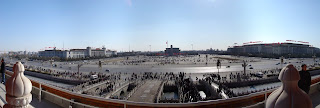 Did you know that March’s Hero of the Month was CSA’s “Tank Man?”
Did you know that March’s Hero of the Month was CSA’s “Tank Man?”
“Tank Man” is the nickname for the man who stood up against the Chinese government by standing in front of a series of military tanks during the Tiananmen Square protests in 1989.
Learn more about the Tiananmen Square Protests of 1989, a crucial moment in China's modern history, and Tank Man as I go over some of the the key facts and the moments leading up to the Tank Man's act of defiance. This is probably the shortest summary of the Tiananmen Square Protests that you will ever read!
-Since 1978, Deng Xiaoping, a head political leader at the time, led a series of economic and political reforms that led to the gradual implementation of a market economy and some political liberalization
-Some students and intellectuals believed that the reforms had not gone far enough and that China needed to further reform its political system.
-The protests were in large measure sparked by the death of former Secretary General Hu Yaobang, who resigned from the position of Secretary General of the CPC
-Hu Yaobang's calls for "rapid reform" and his almost open contempt of "Maoist excesses" made him a suitable scapegoat in the eyes of Deng Xiaoping and others
-Hu Yaobang's sudden death, due to heart attack, on 15 April 1989 provided a perfect opportunity for the students to gather once again, not only to mourn the deceased Secretary General, but also to have their voices heard in "demanding a reversal of the verdict against him" and bringing renewed attention to the pro-democracy protests that had taken place just a couple of years earlier
Protest Development
-Small voluntary civilian gatherings started on 15 April in the middle of the Tiananmen Square in the form of mourning for Hu Yaobang.
-On the afternoon of 17 April in Beijing, 500 students from China University of Political Science and Law marched to the eastern gate of the Great Hall of the People, part of Tiananmen Square, and commenced mourning activities for Hu Yaobang.
-The gathering in front of the Great Hall of the People, a building located in Tiananmen Square used for legislative and ceremonial activities by the government, was soon deemed obstructive to the normal operation of the building, so police intervened and attempted to disperse the students by persuasion.
-Starting at midnight on the night of 17 April, three thousand students from Peking University marched from the campus towards Tiananmen Square, and soon nearly a thousand students from Tsinghua University joined the ranks.
-As its size grew, the gathering gradually evolved into a protest, as students began to draft a list of pleas and suggestions that they wanted the government to listen to and carry through.
-On the morning of 18 April, a few thousand students gathered in front of the Zhongnanhai building complex, the residence of the government, demanding to see government leaders and get answers to their questions.
-On 20 April, police finally dispersed the students in front of the Zhongnanhai by force, to ensure proper function of the building complex. The police employed batons and minor clashes were reported.
-Unlike the Tiananmen protests of 1987, which consisted mainly of students and intellectuals, the protests in 1989 commanded widespread support from the urban workers who were alarmed by the new economic reforms, growing inflation, and corruption.
- On 13 May, two days prior to the highly-publicized state visit by the reform-minded Soviet leader Mikhail Gorbachev, huge groups of students occupied Tiananmen Square and started a hunger strike, insisting the government begin talks with the designated student representatives.
Hunger strikes
-The students decided that to sustain their movement and impede any loss of momentum, a hunger strike would need to be enacted. The hunger strike brought widespread support for the students and "the ordinary people of Beijing rallied to protect the hunger strikers...because the act of refusing sustenance and courting government reprisals convinced onlookers that the students were not just seeking personal gains but (were) sacrificing themselves for the Chinese people as a whole".
June 1989
-Party elders approved the decision to put down the "counterrevolutionary riot" and clear the square with military force. Most hope it can be done without casualties.
-As word spreads that hundreds of thousands of troops are approaching from all four corners of the city, Beijingers flood the streets to block them. At about 10:30 p.m., near the Muxidi apartment buildings -- home to high-level Party officials and their families -- the citizens became aggressive as the army tried to break through their barricades. The soldiers started firing on the unarmed civilians with AK-47s loaded with battlefield ammunition.
Tank Man

-By the morning of June 5, the Chinese army was in complete control of Beijing. But when all protest in the city seems silenced, the world witnessed one final act of defiance.
-About midday, as a column of tanks slowly moved toward Tiananmen Square, an unarmed young man carrying shopping bags suddenly steps out in front of the tanks. Instead of running over him, the first tank tries to go around, but the young man steps in front of it again. They repeat this maneuver several more times before the tank stops and turns off its motor. Soon, the young man is whisked to the side of the road by an unidentified group of people and disappears into the crowd.
To this day, who he was and what became of him remains a mystery.
-------------------------------------------------
CSA is looking into hosting another event next month (April) to continue the discussion about Tank Man! Look out for our emails detailing where this event will be and when!
We hope to see you there!
-------------------------------------------------
If you missed CSA’s showing of The Tank Man, you can watch it online here on the PBS website: http://www.pbs.org/wgbh/pages/frontline/tankman/view/
Tank Man Wikipedia Page: http://en.wikipedia.org/wiki/Tank_Man
Tiananmen Square Protests of 1989: http://en.wikipedia.org/wiki/Tiananmen_Square_protests_of_1989











